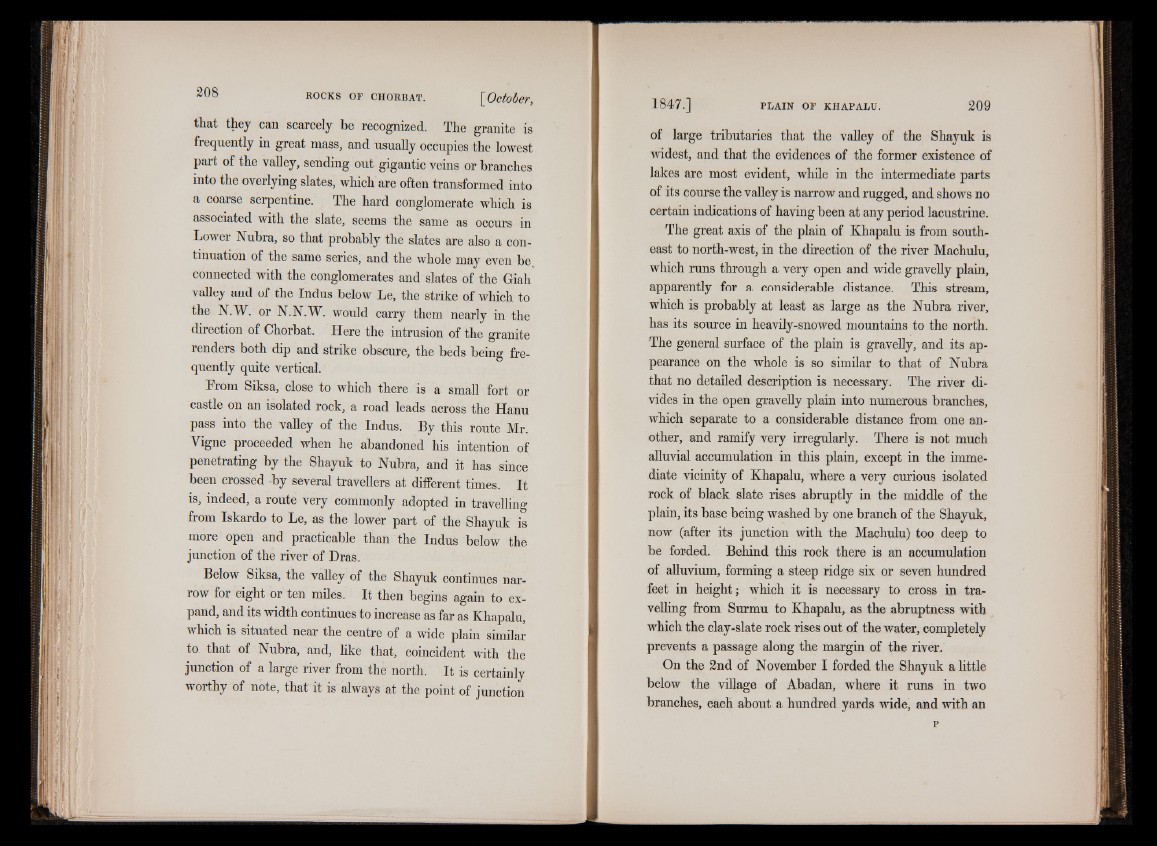
that they can scarcely be recognized. The granite is
frequently in great mass, and usually occupies the lowest
part of the valley, sending out gigantic veins or branches
into the overlying slates, which are often transformed into
a coarse serpentine. The hard conglomerate which is
associated with the slate, seems the same as occurs in
Lower Nubra, so that probably the slates are also a continuation
of the same series, and the whole may even be
connected with the conglomerates and slates of the Giah
valley and of the Indus below Le, the strike of which to
the N.W. or N.N.W. would carry them nearly in the
direction of Chorbat. Here the intrusion of the granite
renders both dip and strike obscure, the beds being frequently
quite vertical.
From Siksa, close to which there is a small fort or
castle on an isolated rock, a road leads across the Hanu
pass into the valley of the Indus. By this route Mr.
Yigne proceeded when he abandoned his intention of
penetrating by the Shayuk to Nubra, and it has since
been crossed by several travellers at different times. It
is, indeed, a route very commonly adopted in travelling
from Iskardo to Le, as the lower part of the Shayuk is
more open and practicable than the Indus below the
junction of the river of Dras.
Below Siksa, the valley of the Shayuk continues narrow
for eight or ten miles. It then begins again to expand,
and its width continues to increase as far as Khapalu,
which is situated near the centre of a wide plain similar
to that of Nubra, and, like that, coincident with the
junction of a large river from the north. It is certainly
worthy of note, that it is always at the point of junction
of large tributaries that the valley of the Shayuk is
widest, and that the evidences of the former existence of
lakes are most evident, while in the intermediate parts
of its course the valley is narrow and rugged, and shows no
certain indications of having been at any period lacustrine.
The great axis of the plain of Khapalu is from southeast
to north-west, in the direction of the river Machulu,
which runs through a very open and wide gravelly plain,
apparently for a considerable distance. This stream,
which is probably at least as large as the Nubra river,
has its source in heavily-snowed mountains to the north.
The general surface of the plain is gravelly, and its appearance
on the whole is so similar to that of Nubra
that no detailed description is necessary. The river divides
in the open gravelly plain into numerous branches,
which separate to a considerable distance from one another,
and ramify very irregularly. There is not much
alluvial accumulation in this plain, except in the immediate
vicinity of Khapalu, where a very curious isolated
rock of black slate rises abruptly in the middle of the
plain, its base being washed by one branch of the Shayuk,
now (after its junction with the Machulu) too deep to
be forded. Behind this rock there is an accumulation
of alluvium, forming a steep ridge six or seven hundred
feet in height; which it is necessary to cross in travelling
from Surmu to Khapalu, as the abruptness with
which the clay-slate rock rises out of the water, completely
prevents a passage along the margin of the river.
On the 2nd of November I forded the Shayuk a little
below the village of Abadan, where it runs in two
branches, each about a hundred yards wide, and with an
p